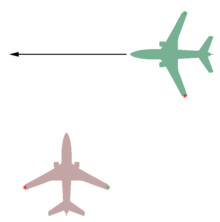Taxiing


Taxiing(rarely spelledtaxying)[1]is the movement of anaircrafton the ground, under its own power, in contrast totowingorpushbackwhere the aircraft is moved by a tug. The aircraft usually moves on wheels, but the term also includes aircraft with skis orfloats(for water-based travel).
An airplane usestaxiwaysto taxi from one place on anairportto another; for example, when moving from ahangarto therunway.The term "taxiing" is not used for the accelerating run along a runway prior totakeoff,or the decelerating run immediately afterlanding,which are called the takeoff roll and landing rollout, respectively.
Etymology
[edit]As early as 1909 aviation journalists envisioned aeroplanes to replace thetaxicabin traffic-congested cities.[2]
Some aviators and some linguists report that around the year 1911 theslangword "taxi" was in use for an "airplane". They suggest that the way aircraft move under power before they take off or after they land reminded someone of the waytaxicabsslowly drove around the block when looking for passengers.[3][4]
Also by 1909, French aviation pioneers likeBlériot,FarmanandVoisinused the term "taxi" for atrainer aircraft,that was so constructed that a pupil would not accidentally get airborne.[citation needed]
Usage of the word for an airplane quickly disappeared again, but the verb "to taxi" stuck, and words like the "taxiway"were derived from it.
Propulsion
[edit]The thrust to propel the aircraft forward comes from itspropellersorjet engines.Reverse thrust for backing up can be generated bythrust reverserssuch as on theBoeing C-17 Globemaster III,or reversible pitch propellers such as on theLockheed C-130 Hercules,a rare procedure known aspowerback.Most aircraft, however, are not designed to back up on their own and must be pushed back either by hand or by using anaircraft tug.
At low power settings, combustion aircraft engines operate at lower efficiency than at cruise power settings. A typicalA320spends an average of 3.5 hours a day taxiing, using 600 liters (160 U.S. gal) of fuel. Hybrid electrically driven nose gear are under development to allow high use aircraft to shut down the engines during taxi operations.[5]
Control
[edit]
Steering is achieved by turning anose wheelor tail wheel/rudder;thepilotcontrols the direction travelled with their feet. Larger jet aircraft have a tiller wheel on the left side of the cockpit that acts as a steering wheel allowing the nosewheel to be turned hydraulically. Braking is controlled by differential toe or heel brakes. Not all aircraft have steerable wheels, and in some cases steering is solely by means of differential braking (allVan's aircraftfor instance) or solely by means of the rudder (including allfloatplanes).
Hover taxi
[edit]
Skid-equippedhelicoptersand otherVTOL(Vertical Take-Off and Landing) aircraft conduct hover taxiing to move inground effectin the same manner that wheel-equipped aircraft ground taxi. In general hover taxis are conducted at speeds up to 20 kn (37 km/h; 23 mph), or belowtranslational lift.[6]
TheBell CH-135 Twin Hueyis hover taxied in a manner typical for skid-equipped aircraft of that size:
This sequence is initiated from a stabilized 5 ft hover. Move the aircraft forward over the ground at a brisk walking pace. Maintain a constant height above ground, constant forward speed and ensure that the skids remain parallel to the direction of movement. Anticipate stopping so that large rearward cyclic applications are not required as this may result in the tail skids striking the ground. You are often required to taxi out of wind; be aware that when taxiing downwind in strong wind conditions there may be insufficient rearward cyclic to ensure adequate control and that the tail will be nearer the ground. Taxiing downwind is limited to 30kts.[7]
Safety
[edit]When taxiing, aircraft travel slowly. This ensures that they can be stopped quickly and do not risk wheel damage on larger aircraft if they accidentally turn off the paved surface. Taxi speeds are typically 16 to 19 kn (30 to 35 km/h; 18 to 22 mph).[8]
Rotor downwash limits helicopter hover-taxiing near parked light aircraft. The use of engine thrust near terminals is restricted due to the possibility of structural damage or injury to personnel caused byjet blast.[9]
References
[edit]- ^Dept, United States Air Force (1956).United States Air Force Dictionary.p. 515.
- ^Flight,Volume 1, 1909-12-11, page 804.
- ^"Why is taxiing (As done by airplanes, etc) called that?".
- ^"Taxi | Etymology, origin and meaning of taxi by etymonline".
- ^Majcher, Kristin (1 April 2011)."Torque Test: The German Aerospace Center unveils a silent, emissions-free electric nose wheel drive system for the Airbus A320".Aviation Week Network.Aviation Week. Archived fromthe originalon 18 May 2017.Retrieved2011-04-22.
The new, electric nose wheel can power the A320 both forward and backward without requiring power from the aircraft's main engine. In addition to the energy savings, the electric nose wheel completely eliminates engine noise during taxi maneuvers.
- ^Crane, Dale:Dictionary of Aeronautical Terms, third edition,page 263. Aviation Supplies & Academics, 1997.ISBN1-56027-287-2
- ^10 Tactical Air Group:CFACM 40-35 CH-135 Standard Maneuver Guide,page 1-1, section 103 Taxiing (unclassified). Canadian Forces Air Command, 1984
- ^"A Statistical Learning Approach to the Modeling of Aircraft Taxi-Time"(PDF).MIT Lincoln Laboratory.Federal Aviation Administration. 10 Aug 2010. p. 4.Archived(PDF)from the original on April 26, 2014.
- ^"Engine Thrust Hazards in the Airport Environment".www.boeing.com.
External links
[edit] Media related toTaxiwaysat Wikimedia Commonsaircraft
Media related toTaxiwaysat Wikimedia Commonsaircraft Media related toTaxiing in aviationat Wikimedia Commons
Media related toTaxiing in aviationat Wikimedia Commons
